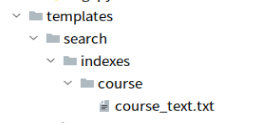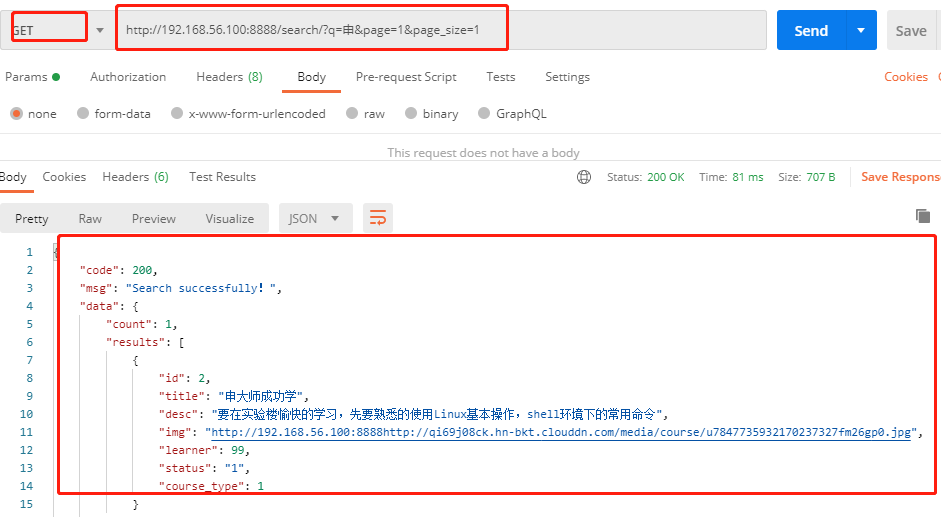-
1.安装
pip install drf-haystack # django的开源 搜索框架(python语音写的,搜索框架可以使用其他 语音的搜索引擎) pip install whoosh # 搜索引擎(python语音写的) pip install jieba # 中文分词Jieba,由于Whoosh自带的是英文分词,对中文的分词支持 不是太好
2. syl/settings.py 全文检索配置
'''1.注册app ''' INSTALLED_APPS = [ 'haystack', # haystack要放在应用的上面 ] '''2.模板路径 ''' TEMPLATES = [ { 'DIRS': [os.path.join(BASE_DIR,'templates')], }, ] '''3.全文检索配置''' HAYSTACK_SEARCH_RESULTS_PER_PAGE = 15 # 搜索出多条数据时需要分页 HAYSTACK_CONNECTIONS = { 'default': { # 'ENGINE': 'haystack.backends.whoosh_backend.WhooshEngine', 'ENGINE': 'course.whoosh_cn_backend.MyWhooshEngine', 'PATH': os.path.join(BASE_DIR, 'whoosh_index'), # 指定倒排索引 存放位置 }, }
# # ES引擎
# HAYSTACK_CONNECTIONS = {
# 'default': {
# 'ENGINE': 'haystack.backends.elasticsearch_backend.ElasticsearchSearchEngine',
# 'URL': 'http://10.211.55.15:9200/', # Elasticsearch服务器ip地址,端口号固 定为9200
# 'INDEX_NAME': 'syl', # Elasticsearch建立的反向索引库的名称
# },
# }
# # 添加此项,当数据库改变时,会自动更新索引,非常方便
# HAYSTACK_SIGNAL_PROCESSOR = 'haystack.signals.RealtimeSignalProcessor'
2.2 在子应用下创建索引文件
- apps/course/search_indexes.py
# apps/course/search_indexes.py # 文件名必须是 search_indexes.py from haystack import indexes from .models import Course # 修改此处,类名为模型类的名称+Index,比如模型类为GoodsInfo, # 则这里类名为GoodsInfoIndex(其 实可以随便写) # class CourseIndex(indexes.SearchIndex, indexes.Indexable): """ Course索引类 """ # text为索引字段 # document = True,这代表haystack和搜索引擎将使用此字段的内容作为索引进行检索 # use_template=True 指定根据表中的那些字段建立索引文件的说明放在一个文件中 text = indexes.CharField(document=True, use_template=True) # 对那张表进行查询 def get_model(self): # 重载get_model方法,必须要有 """返回建立索引的模型类""" return Course # 返回这个model # 建立索引的数据 def index_queryset(self, using=None): """返回要建立索引的数据查询集""" # 这个方法返回什么内容,最终就会对那些方法建立索引,这里是对所有字段建立索引 return self.get_model().objects.all()
2.3 指定索引模板文件
- syl/templates/search/indexes/course/course_text.txt
- # 创建文件路径命名必须这个规范:templates/search/indexes/应用名称/模型类名称
_text.txt

{{object.id}}
{{object.title}}
{{object.desc}}
2.4 修改为jieba分词中的中文分析器
- apps/course/whoosh_cn_backend.py
# 更换 text 字段的 分析方式, 变为jieba分词中的中文分析器 from haystack.backends.whoosh_backend import WhooshEngine, WhooshSearchBackend from whoosh.fields import TEXT from jieba.analyse import ChineseAnalyzer class MyWhooshSearchBackend(WhooshSearchBackend): def build_schema(self, fields): (content_field_name, schema) = super().build_schema(fields) # 指定whoosh使用jieba进行分词 schema._fields['text'] = TEXT(stored=True, analyzer=ChineseAnalyzer(), field_boost=fields.get('text').boost, sortable=True) return (content_field_name, schema) class MyWhooshEngine(WhooshEngine): backend = MyWhooshSearchBackend
2.5 课程全文检索接口视图函数
- course/views.py
# 课程全文检索接口视图函数 from syl import settings from django.core.paginator import InvalidPage, Paginator from haystack.forms import ModelSearchForm from django.http import JsonResponse # 如果settings.py中配置就是用settings中配置的,否则就每页 15 条 RESULTS_PER_PAGE = getattr(settings, 'HAYSTACK_SEARCH_RESULTS_PER_PAGE', 15 ) def course_index_search(request): #1.获取前端传过来的关键字(查询数据) query = request.GET.get('q', None) page = int(request.GET.get('page', 1 )) # 第几页 page_size = int(request.GET.get('page_size', RESULTS_PER_PAGE)) #每页多少条 #2.获取查询条件,进行查询 if query: form = ModelSearchForm(request.GET, load_all=True) # 将查询条件传递给查询对象 if form.is_valid(): results = form.search() # 查询出来的最终数据 else: results = [] else: return JsonResponse({"code": 404 , "msg": 'No file found!', "data": []}) #3.对结果集进行分页 paginator = Paginator(results, page_size) try: page = paginator.page(page) # 从分好的页中拿第几页 except InvalidPage: # 如果分页出错 return JsonResponse({"code": 404 , "msg": 'No file found!', "data": []}) #4.把查询的分页结果集对象转换成json格式 jsondata = [] for result in page.object_list: # 分页后的课程查询结果 data = { 'id': result.object.id, 'title': result.object.title, 'desc': result.object.desc, 'img': request.scheme + '://' + request.META['HTTP_HOST'] + result.object.img.url, # 'follower': result.object.follower, 'learner': result.object.learner, 'status': result.object.status, 'course_type': result.object.course_type.id } jsondata.append(data) result = { "code": 200, "msg": 'Search successfully!', "data": {"count": page.paginator.count, "results": jsondata} } return JsonResponse(result)
2.6 syl/urls.py 添加路由
urlpatterns = [ path('search/', course_index_search), ]
2.7 命令构建倒排索引
python manage.py rebuild_index
3.测试课程全文检索
- 测试接口
-
http://192.168.56.100:8888/search/?q=申&page=1&page_size=1
- 测试结果
